Windows Phone 8.1 Review
by Anand Lal Shimpi on April 14, 2014 10:00 PM EST- Posted in
- Smartphones
- Microsoft
- Mobile
- windows phone
- Windows Phone 8.1
Wi-Fi and Data Sense
Windows Phone 8.1 includes automatic handling for a large number of WiFi hotspot captive portals. If enabled, your phone will automatically agree to any terms and even automatically provide a name and email address to get you past the portal.
The new Wi-Fi Sense feature also allows sharing of Wi-Fi credentials with other WP8.1/Wi-Fi Sense users. The users on the other end never see passwords, they’re just automatically allowed to join networks you choose to share. This is one feature I wasn’t able to test as I only had a single WP8.1 device.
Where Wi-Fi Sense attempts to make joining Wi-Fi networks easier, Data Sense tries to help you manage bandwidth usage on cellular networks. The new tool gives you insight into how much bandwidth all of your apps are using, down to a split between cellular and WiFi traffic.
You can input how much cellular data you’re allocated each month and Windows Phone 8.1 can automatically monitor your cellular data usage and respond appropriately as you approach your data limit. WP8.1 can restrict background data usage, as well as reduce bandwidth requirements for Internet Explorer.
With IE11 on Windows Phone 8.1 Microsoft introduced optional server side web page compression. Similar to Amazon’s Silk browser’s accelerated page loading, Microsoft’s Browser Optimization Service (BOS) uses a proxy server to compress images, HTML and JavaScript before sending the contents to your device. MS claims to not store any personal data during the process. When enabled (either manually or automatically triggered by Data Sense), Microsoft claims the compression can save up to 45% of your browsing data usage in standard savings mode or up to 70% in high savings mode.
I setup a web server and looked at the impact of BOS on image compression. Below are some samples taken from our Galaxy S 5 review when viewed in IE11 with BOS disabled, standard savings enabled and with high savings enabled.


With the most aggressive compression enabled, the impact on file size and image quality is pretty substantial. Microsoft provides a simple override if you want to load a full quality version of the page without diving back into the Data Sense settings.

Tap the override symbol (to the left of anandtech.com) to load the full web page
The standard compression image honestly doesn’t lose a ton of quality, but the savings on already compressed images aren’t huge.
| BSO Impact on Image Sizes | ||||||
| No Compression | Standard Compression | High Compression | ||||
| Night Shot (Image #1) | 57KB | 41KB (71.9%) | 38KB (66.7%) | |||
| Product Shot (Image #2) | 284KB | 253KB (89.1%) | 182KB (64.1%) | |||
In high savings mode IE11 will also prevent loading long pages and avoid loading some ads. Visiting AnandTech’s mobile site with BOS set to high revealed a mostly useless front page with nothing more than the main logo but that seemed to be the exception as we have a rather image heavy front page. As it’s optional, I can see BOS being important to some users on aggressively capped data plans.
IE11
There’s a running joke at AnandTech that the only thing mobile IE10 was optimized for was SunSpider. While javascript performance optimization has become a primary pursuit in Android and iOS, the only javascript test that seemed really fast on IE in Windows Phone 8 was SunSpider. If I ran any of our less well known js tests I either got scores that represented phones from a couple of years ago or the browser couldn’t complete the test. Windows Phone 8.1 integrates IE11 and with it comes a number of performance optimizations.
SunSpider doesn't show a meaningful increase in performance (likely because it's already thoroughly optimized for). The good news is the rest of our js suite does get substantially better:
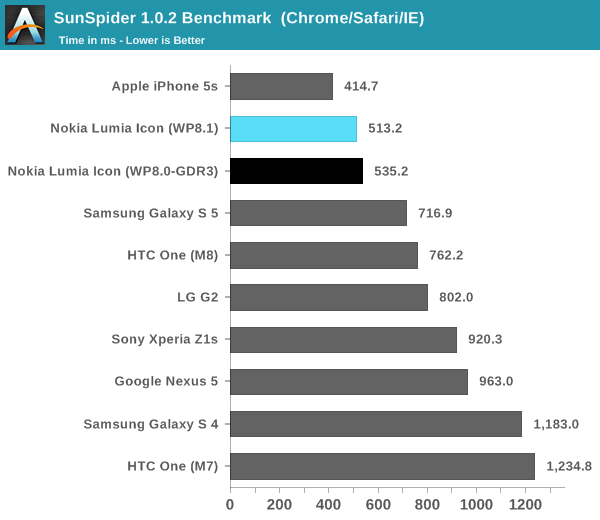
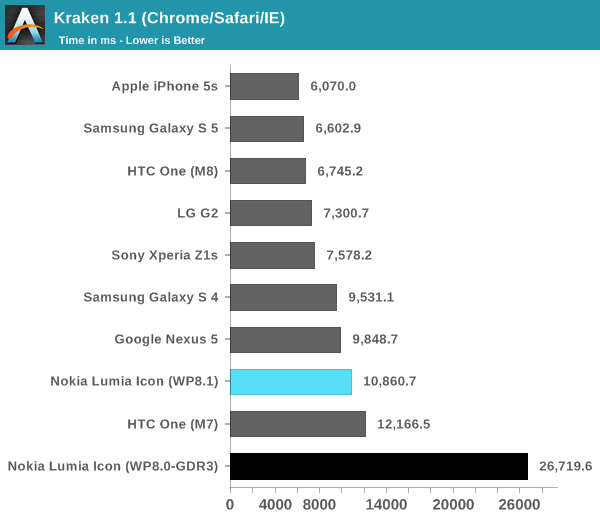
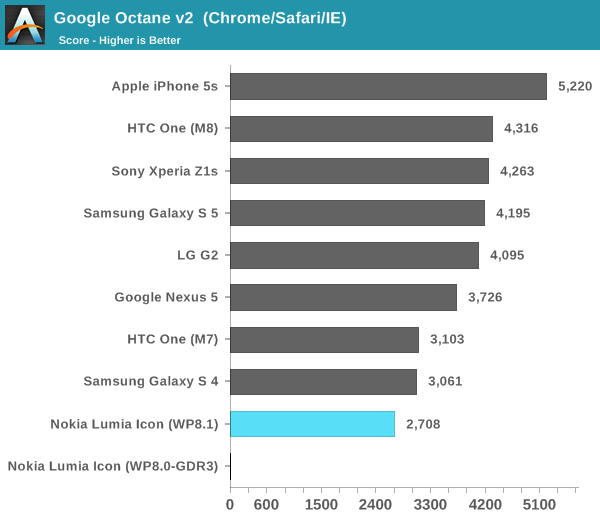
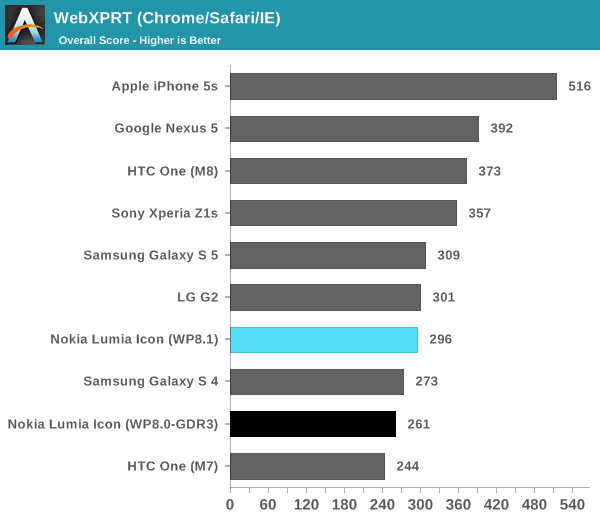
Kraken completes in less than half the time than it did in WP8.0. Octane actually completes now instead of hanging during the asm test, and WebXPRT sees a 13% increase in performance as well. IE11 definitely isn’t the fastest mobile browser on the planet, but it at least moves WP8.1 towards a more modern level of performance. Note in the case of WebXPRT running on the Lumia Icon, we're at performance that's nearly equal to the LG G2 - also using a Snapdragon 800 SoC. That's one of the slowest examples of S800 running Android however. The Nexus 5 by comparison does substantially better - there's still room for improvement in IE11's js performance.
I did notice improvements in actual page load times however it seems to me that there’s a bit of image compression going on even when I have Data Sense disabled which effectively invalidates any comparison results. It’s not clear to me if this is intentional or a bug with the dev preview at this point. In side by side comparisons, Mobile Safari running on the iPhone 5s still manages to load pages faster than IE11 running on the Lumia Icon, despite whatever image compression may be active on the WP8.1 device. It just goes to show you that having the fastest silicon does matter.
IE11 is more compatible than its predecessor. Running HTML5Test the new browser gets a score of 378, compared to 328 in IE10. Chrome for Android and Mobile Safari both score higher however.
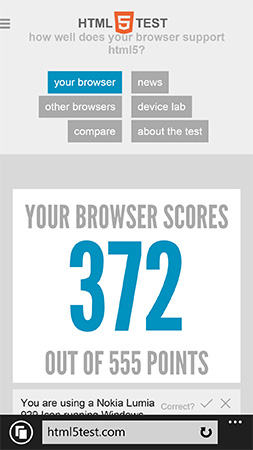
I’ve included a screenshot gallery showing the individual scores, but the new browser wins a lot of points by including support for things like WebGL. Despite adding WebGL support however, I couldn’t get the old aquarium test to actually animate on the device.
IE11 sees functional improvements compared to its predecessor as well. The refresh button at the bottom of the screen has been replaced by a tabs button (you can change it back if you’d like). You can now also swipe right/left to go back/forward through your history in a tab. There’s better YouTube support with IE11 as well. You can now play YouTube videos within an embedded page instead of always being forced out into a full screen mode.
Performance
Since its incarnation, Windows Phone has always been late in adopting high end silicon. It normally wouldn’t be a problem if the platform primarily targeted entry level and mainstream consumers, however for much of its recent life Windows Phone has pursued the high end particularly with Nokia’s flagship devices. The result was a platform that had a high end camera, but with a mainstream SoC. It wasn’t too long ago that Microsoft was parroting the dual-core isn’t necessary for performance and is bad for battery life mantra, but it’s good to see that’s now over with.
Qualcomm remains the sole silicon provider for Windows Phone, which is fine given their position of dominance and the lack of any appreciably better alternatives. With the GDR3 update to Windows Phone 8 Microsoft added support for Snapdragon 800. Although that SoC has since been superseded by the Snapdragon 801, Windows Phone 8/8.1 at least support the highest end mobile silicon family available today.
The Lumia Icon was my first Windows Phone experience on Snapdragon 800, and I have to say it is quite good. Launching and switching between apps is pretty quick and the OS as a whole feels nice and responsive. Having spent the past few weeks in Android and iOS 7.1 land, the Windows Phone 8.1 UI animations seem a bit excessive but no where near as bad as iOS 7.0. The platform overall is quite pleasant to use and never really feels slow, at least with the S800 under the hood.
There are a few native benchmarks available on the Windows Phone Store, which I used to track changes in system performance between WP8 and 8.1. I didn’t find much of a delta between the two platforms:
| Windows Phone 8.1 vs. 8.0 GDR3 Performance | ||||||
| BaseMark OS II | BaseMark X 1.1 (Medium, Overall) | GFXBench 2.7 (T-Rex HD, Onscreen) | ||||
| Windows Phone 8.1 (Lumia Icon) | 1046 | 25536 | 25 fps | |||
| Windows Phone 8.0 GDR3 (Lumia Icon) | 1033 | 24748 | 25 fps | |||
The individual BaseMark OS II scores are worth drilling down on as they expose the improvements in web rendering performance, as well as highlight a slight regression in some of the other areas:
| Windows Phone 8.1 vs. 8.0 GDR3 Basemark OS II Performance | |||||||
| System | Memory | Graphics | Web | ||||
| Windows Phone 8.1 (Lumia Icon) | 921 | 1492 | 1409 | 619 | |||
| Windows Phone 8.0 GDR3 (Lumia Icon) | 1146 | 1474 | 1192 | 566 | |||
The slight drop in system performance (these are mostly CPU bound tests) is unusual, but this is a dev preview of WP8.1. IO performance (memory suite) doesn't change, but graphics and web performance both go up. I suspect there are some improvements on the GPU driver front, which are responsible for the uptick in graphics performance. The increase in web rendering performance is also made evident here.


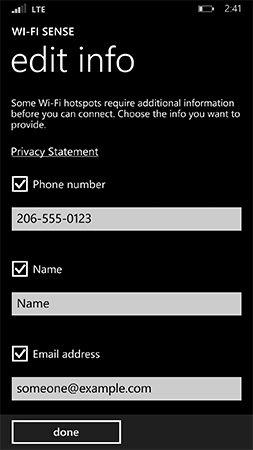
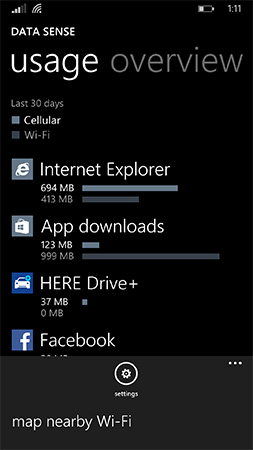
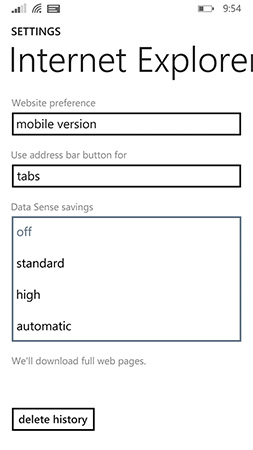
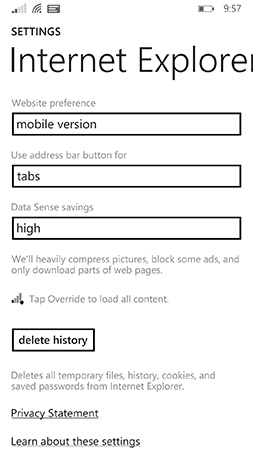
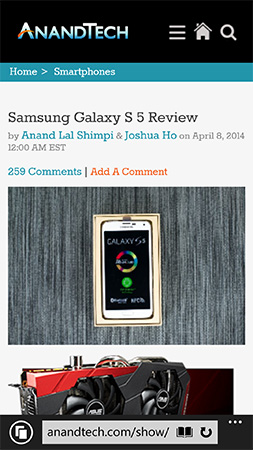














111 Comments
View All Comments
HardwareDufus - Wednesday, April 16, 2014 - link
Running Win Phone 8.1 now on my Nokia 920. Decent improvements. Overall I'm satisifed.Echo everyone's sentiments on the Music App... can't believe I preferred the Built-In Music App on my BlackBerry Torch 9800. Anyway, the music App is not a deal breaker for me, but I am surprised that it feels so unpolished. How do you close a song? Once I play a song. If I stop it... well it's still there... so, I work the Volume controls several hours later... and up pops the song in a Little slider window (not really a pop-up.. but you know what I mean). I've even done the hold the back button... hit the X or SLide down the window gesture.... Yup... 'In My Place' by ColdPlay is still waiting to resume play (hey.... I'm old... I still like Coldplay).
BMNify - Thursday, April 17, 2014 - link
the Xbox music app is now delinked from phone and will received direct updates from store, the next update should come out by next week which should take care of some of the complaints and after than they have promised biweekly updates, so should solve most of the user complaints within few weeks.nicktina - Friday, April 18, 2014 - link
I was going crazy trying to figure out how to get the paused music app off my volume keys. The 1st thing I figured out was if I opened Pandora I could stop the playback from Pandora and that would take care of it. But today I found an app that's free this weekend called "stop the music". I pinned it to my start screen. I opened Nokia mix radio, backed out to start screen, tapped the stop the music app and it was gone. Silly it takes a 3rd party app to remove music but whatever, it works.Arbie - Wednesday, April 16, 2014 - link
Thanks for the tips re Cortana and MagikMail. But these are approximately infinitely more complicated than I want to get into, even to obtain a whitelist surrogate. I don't use my phone on-line, for mail, data, or anything like that. It's primarily a small media player with phone capability when I need it. And it's great for that, at the price.I just... want... whitelist.....
Arbie - Wednesday, April 16, 2014 - link
Thanks for the info. I am looking forward to using that feature. BTW I did try cleaning my SIM card but that didn't help.ctodd - Wednesday, April 16, 2014 - link
I really want to like WP! Its very tempting, but after being abandoned on an 8 month old 7.1 device, I'm leery to take the plunge again. It is exciting to see them finally catch up on the features but I'm still a little put off with the overly flat look. I like the idea of tiles, but everything else is just too flat and boring. I was hoping they would optimize the look by adding a little more depth and color but I guess they just want to be different.BMNify - Thursday, April 17, 2014 - link
Dude, the latest WP 8.1 update has great depth and colour to tiles along with some paralax like effect, you should just check out some 8.1 phone for that, i am enjoying changing background of the tiles now after 8.1 update, just check out some examples and how to do it here: http://www.wpcentral.com/how-get-beautiful-start-b...gamoniac - Thursday, April 17, 2014 - link
My 1.5 years old, 2-core Lumia 920 (WP 8.1) scores 968 on html5test.com. So it looks like perhaps WP8.1 limits the max core an app can use to conserve resources or to guarantee responsiveness. Or perhaps IE 11 is not optimized for 4 cores, IDK. Regardless, I love the upgrade and my old phone is as snappy as it was the first day I got it. Kudos to Microsoft.gamoniac - Thursday, April 17, 2014 - link
@Anand, I have had bad experiences with Android updates in both the phone and tablet spaces. Besides Google's own Nexus line of phones, do major phone manufacturers give their consumers fair and prompt Android patches?Hrel - Friday, April 18, 2014 - link
"All devices capable of running Windows Phone 8 will be getting the 8.1 update for free over the next couple of months" - This is probably Android's biggest shortcoming. I can buy a brand new phone, with a 6 month old OS that will NEVER get an update. It's pretty infuriating. Now yes, I am techie enough root the phone, but that's not an elegant solution, to say the least.I don't know if it would require locking in a certain number of SOC configurations or what, but I really think Google needs to guarantee OS updates for at LEAST 2 years from the phones release.
IF things go on the way they are, I can see myself switching away from Android and over to Windows Phone. Probably be up OS9 by then, so hopefully this stupid "tile" bullshit is gone and we can have actual windows and icons again. Seriously $soft, the functionality of these "tiles" is infuriating.